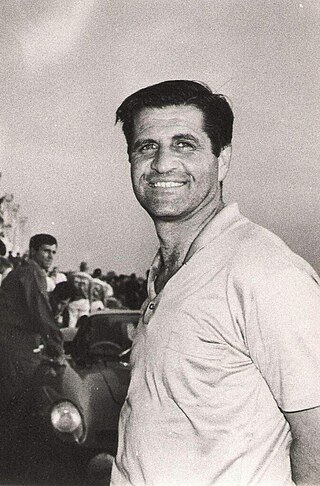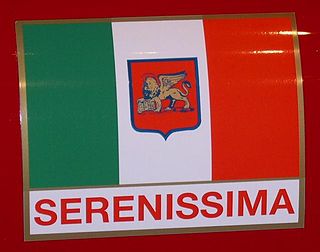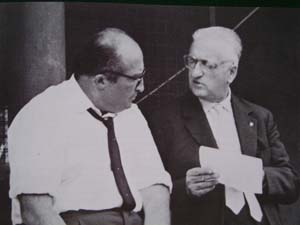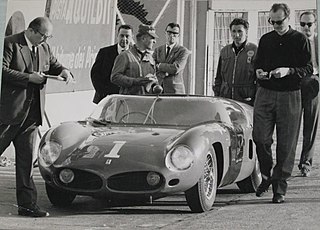
Enzo Anselmo Giuseppe Maria Ferrari was an Italian motor racing driver and entrepreneur, the founder of the Scuderia Ferrari Grand Prix motor racing team, and subsequently of the Ferrari automobile marque. He was widely known as il Commendatore or il Drake. In his final years he was often referred to as l'Ingegnere or il Grande Vecchio.

ASA was an Italian automobile manufacturer active from 1961 to 1969, who is known for manufacturing the ASA 1000 GT. This car was developed by Ferrari engineers in the late 1950s as a less expensive, compact alternative to existing Ferrari GT cars. ASA used inline-four and straight-six engines derived from the "250" 3-litre V12 designed by Gioacchino Colombo. The chassis was developed by Giotto Bizzarrini and was derived from the tubular frame chassis of the 250 GTO.
ATS is an Italian automotive constructor. It once had a racing team that operated between 1963 and 1965, formed after the famous "Palace Revolution" at Ferrari.

The Ferrari 250 GTO is a grand tourer produced by Ferrari from 1962 to 1964 for homologation into the FIA's Group 3 Grand Touring Car category. It was powered by Ferrari's Tipo 168/62 Colombo V12 engine. The "250" in its name denotes the displacement in cubic centimeters of each of its cylinders; "GTO" stands for Gran Turismo Omologato, Italian for "Grand Touring Homologated".

The Ferrari 250 is a series of sports cars and grand tourers built by Ferrari from 1952 to 1964. The company's most successful early line, the 250 series includes many variants designed for road use or sports car racing. 250 series cars are characterized by their use of a 3.0 L (2,953 cc) Colombo V12 engine designed by Gioacchino Colombo. They were replaced by the 275 and 330 series cars.

Piero Drogo was a racing driver and coachbuilder from Italy. He participated in one Formula One Grand Prix, debuting at the 1960 Italian Grand Prix. He moved on to form a carrozzeria in Modena to service the thriving sports car industry there. His Carrozzeria Sports Cars gained some fame later in the decade. He died in a car accident aged 46.

Bizzarrini S.p.A. was an Italian automotive manufacturer. In 1964, the company was founded by former Alfa Romeo, Ferrari and Iso engineer Giotto Bizzarrini. The company built a small number of highly developed and advanced sports and racing automobiles before failing in 1969. In 2020, it was announced that the name had been acquired by Pegasus brands, together with plans to restart production.

Giotto Bizzarrini was an Italian automobile engineer who was active from the 1950s through the 1970s.
Ferrari is an Italian company which has produced sports cars since 1947, but traces its roots back to 1929 when Enzo Ferrari formed the Scuderia Ferrari racing team.

Scuderia Serenissima or Scuderia SSS Republica di Venezia was an auto racing team funded by Giovanni Volpi and active in the early 1960s. The name "Serenissima" refers to one of the many definitions the city of Venice is known for, the Volpi family being originally from the area. Based in Sasso Marconi, close to Bologna, Serenissima mostly competed in Formula One and sports car racing. Originally the team had an engine supply agreement with Ferrari. When Volpi decided to financially support ATS, a Formula One team put together by Carlo Chiti, Giotto Bizzarrini, Romolo Tavoni and other breakaway Ferrari employees, Enzo Ferrari withdrew from the agreement. Serenissima subsequently turned to De Tomaso and Maserati without much success. Serenissima officially closed in 1970.

Carrozzeria Sports Cars was a small carrozzeria in Modena, Italy, which produced sports and racing car bodies from 1960 until 1971. The company was founded by one-time Formula One driver, Piero Drogo along with coachbuilders Lino Marchesini and Celso Cavalieri. As the public face of the company, Drogo's name became synonymous with the cars produced by C.S.C., which are often referred to as "Drogo" bodies or designs. The workshop constructed bodies for many companies, racing teams and individuals including Scuderia Ferrari, Scuderia Serenissima, Iso and Giotto Bizzarrini. Financial difficulties led to the closure of Carrozzeria Sports Cars in 1971.

The Ferrari 250 GT SWB Breadvan is a one-off Ferrari made in 1962 from a 1961 Ferrari 250 GT Berlinetta SWB, chassis number 2819 GT. It was built to compete against the new 1962 Ferrari 250 GTO at the 24 Hours of Le Mans and other FIA World Sportscar Championship races.

Carlo Maria Abate was an Italian auto racing driver. He was one of the best Ferrari 250 GTO specialists. Abate preferred to be addressed as "Carlo Mario Abate" instead of his christened name.

The 1962 24 Hours of Le Mans was a motor race for Experimental cars and Grand Touring cars, staged at the Circuit de la Sarthe, Le Mans, France on 23 and 24 June 1962. It was the 30th Grand Prix of Endurance and the eighth round of the 1962 International Championship of Manufacturers.

Mauro Forghieri was an Italian mechanical engineer, best known for his work as a Formula One racing car designer with Scuderia Ferrari during the 1960s and 1970s. He is credited with introducing the first designed rear wings to Formula One at the 1968 Belgian Grand Prix. He oversaw numerous technical developments during his tenure at Ferrari, including the creation of the 250 GTO and P-series sports racing cars, the Ferrari flat-12 series of engines, Ferrari's first turbocharged engine in the 126 C F1 car, and a prototype semi-automatic transmission in 1979. During Forghieri's tenure with Ferrari, the company won the F1 World Driver's Championship four times and the F1 World Constructors' Championship seven times. After leaving Ferrari in 1987, he worked at Lamborghini and Bugatti then founded the Oral Engineering Group in 1995.

Carlo Chiti was an Italian racing car and engine designer best known for his long association with Alfa Romeo's racing department. He also worked for Ferrari and was involved in the design of the Ferrari 156 Sharknose car, with which Phil Hill won the 1961 championship.

Giuseppe Volpi, 1st Count of Misurata was an Italian businessman and politician.

The ATS 2500 GT is a sports car made by Italian company Automobili Turismo e Sport in Bologna. It was the first Italian and one of the first GT or sports car in the world to have a mid-engine layout. The group behind the ATS project consisted mainly of Ferrari defectors: family troubles had created an uncomfortable working atmosphere for the personnel. ATS, intent on beating Ferrari on all fronts, also produced a Formula One car for 1963, "a ghastly mess, one of the most inept racing cars ever, and its appalling performances did not help the road car." Even noted driver Phil Hill was unable to provide ATS with any results on track.
Neri and Bonacini, also known as Nembo, was a small carrozzeria and mechanic shop based in Modena, Italy, active from the late 1950s to around 1967. Founded and run by Giorgio Neri and Luciano Bonacini, the shop worked on and produced bodies for Ferrari, Lamborghini and Maserati road and race cars, both in an official capacity for those manufacturers and for private owners. Their best known projects are the Ferrari 250 GT-based Nembo spiders and the Lamborghini 400GT Monza. Neri and Bonacini also designed a car under their own name, the Neri and Bonacini Studio GT Due Litri. Two prototypes of this car were made between 1966 and 1968 but it never entered series production. The shop closed around 1967 when Bonacini went to work for De Tomaso and Neri started his own shop, Motors-World-Machines (MWM).

Romolo Tavoni was an Italian sports executive best known for his work at Ferrari.

















